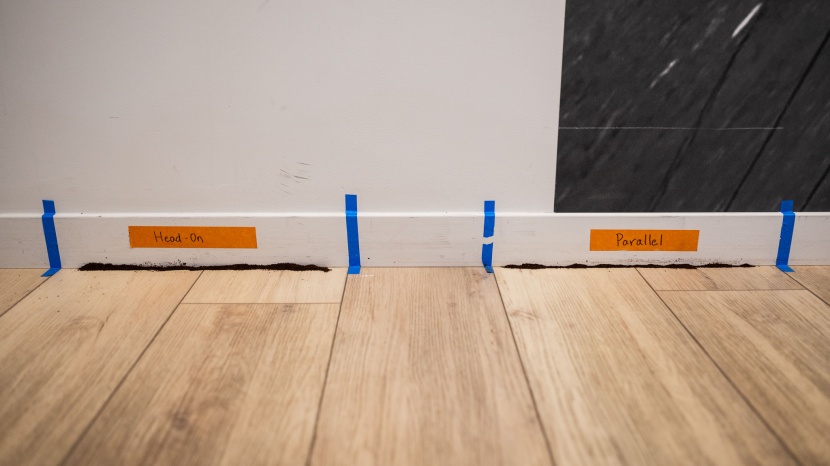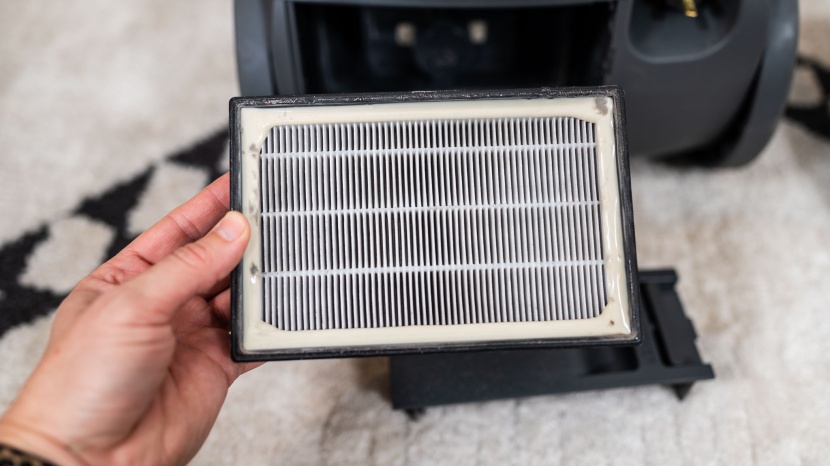Testing vacuums is not an easy task, which is why we developed a series of objective tests in our state-of-the-art lab. We cared mostly about how the canisters performed on carpet and hardwood but extended our tests to include ease of use, filtration, and suction. Below, we outline exactly how we determined the scores in our testing.
Carpet Performance
Our carpet tests were comprised of two subtests: low pile and high pile. They were carried out the same way. We measured out a cup and a half of Cheerios, rice, and sand, mixing them together and dumping them on our test rugs. Then, we set the vacuums to work for 24 seconds. We determined 24 seconds was the average time spent vacuuming this particular area of carpet, and to keep it as realistic as possible, this is how long we cleaned for. After this, we weighed the contents collected and compared it to the original weight. We were able to calculate a percentage with this information. This exact test was repeated for high-pile carpet. Along the way, we made detailed notes of why the vacuums performed the way they did.
Hardwood Performance
Our hardwood tests were comprised of three subtests: hardwood cleaning, crevice cleaning, and edge cleaning. Let's break it down.
Hardwood Cleaning
This test was very similar to our carpet cleaning test, but, you guessed it, was done on hardwood flooring instead. We mixed Cheerios, sand, and rice, dumping it on our hardwood section. After 24 seconds of cleaning, we weighed the amount of debris collected. This was translated into a percentage to let us know exactly how well the vacuum cleaned. With that, we kept notes on how easy it was to do so.
Crevice Cleaning
Tricky spots exist when cleaning, like small cracks and crevices. Sand and small debris make their way in and have a tough time ever getting out. We took this into consideration and designated a subtest to it. We used a bamboo mat with slots to do so. We measured out 21 grams of bright red sand and placed it within the crevice. Then we vacuumed the surface four times to and fro. After which, we weighed the collected sand and compared it to the original weight.
Edge Cleaning
Edges are another typically tough location for vacuums to clean, but some canister vacuums excel here. We conducted a test to see which could actually handle it. We sprinkled two tablespoons of coffee grounds along two 16-inch sections of baseboard. We vacuumed the first mess head on going straight into the wall. Then we vacuumed the second mess, moving parallel to the wall. We collected notes along the way. Some could handle both, while some could only capture the grounds in one direction.
Ease of Use
This metric was broken down into three subtests: maneuverability, ease of cleaning, and upholstery/attachments.
Maneuverability
Here we took the weight of every vacuum, lifting, and moving it around to see how heavy it felt. Then we used the vacuums on an obstacle course of different floor types. We noted how well it moved around, and if it had any troubles with tight corners or under furniture.
Ease of Cleaning
Here, we are referring to how easy it was to clean the machine, not the floor. Most canisters have disposable bags and filters that need to be changed out. We did this, noting how easy it was to do so and if there were any troubles along the way. Those few that don't have bags were also cleaned and assessed. Some needed to get taken fully apart to clean, and we took this into consideration.
Upholstery and Attachments
We then assessed the attachments included with the vacuum. Some include a lot of attachments, while others had just a few. Neither is necessarily better than the other, especially if one or two tools get the job done. We tested the attachments by sprinkling coffee grounds on a throw pillow. We then made one pass, sucking up as much as we could get.
Pet Hair
Some vacuums love pet hair, while others can't seem to grasp it. We collected pet hair from our real pets at home, brought it into the lab to be weighed, and massaged it into the carpet. We did this with both low- and high-pile carpets. After which, we put the vacuums to work for 12 seconds. We then weighed the final amount collected and compared it to the original weight. If any issues came up during our testing, we were sure to note it.
Filtration and Suction
Our final tests were on filtration and suction. Below we break these both down.
Filtration
We used two Dylos particle counters while running the canister vacuums to see how much emissions they had. Ideally, no particles make their way out of the vacuum, which is where a good filtration system comes into play. We tested for both small and large particles, noting the average peak of both. Those that less particulate emission, had a higher score.
=Suction=
We developed a state-of-the-art suction test to determine how strong each canister vacuum was. Our test surface has a small hole in the center that is attached to a manometer, a device to measure pressure. As we passed over this hole, we were able to capture an unsealed suction pressure. In the past, we collected sealed suction. However, we didn't find this to be as realistic to how the vacuums would perform in your home.






